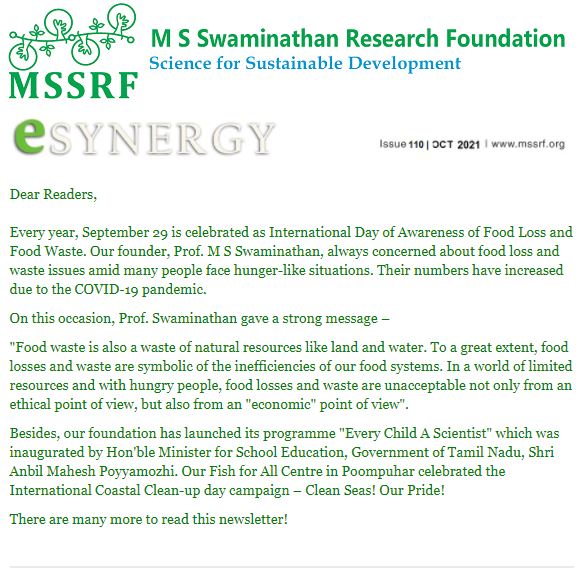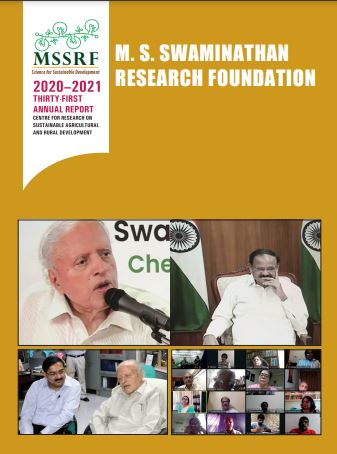Women’s role in agriculture is of the utmost importance not only for developing the rural economy but also in ensuring food security. During COVID-19 lockdown in India, women’s unpaid workload in both domestic chores and care for family has noticeably increased. Here, Dr Pratheepa and Dr Rengalakshmi from the M.S. Swaminathan Research Foundation (MSSRF) describe the situation faced by agricultural labour families in their study area for TIGR2ESS Flagship Project 1 and how women are tackling the lockdown period.
Most of the women agricultural labourers in Sirkazhi block of Nagapattinam district depend on agricultural work as their primary source of livelihood. In a year, women barelygetthree to four months’ work as yearly cultivation has shifted from triple cropping to single cropping paddy because of increasing water and soil salinity. Since the seasonal work wage is very minimal, up to just INR 150 (GBP 1.60) per day, the long off-season (February-August) where women are without work combined with increasing numbers of non-earning days means women easily fall into continuous debt.
The risk of debt is even greater for the Dalit families (socially disadvantaged sections) as both men and women depend on agricultural daily wage work for their livelihood. In such a situation, ultimately the burden of ensuring a ready household food supply falls on the woman’s head. The COVID-19 lockdown has placed extraordinary strain on these families, as every labourer is now jobless indefinitely. A woman from one of these families told us about the challenges they face even in normal times:
“As the summer season begins in April month, demand for women’s labour in agriculture is getting reduced each year due to less possibility of cultivation. A few men and women engage in brick making work. People with goats make some money by selling their goats and manage with this income for a month or few weeks. Apart from this, it is really difficult for us to run the family in off-season – most of us will pawn our gold and some will borrow money from money lenders.”
There is no other work in these villages other than plucking cotton,which starts from first week of May only. The only opportunity labour families get during the off-season is Mahatma Gandhi National Rural Employment Gurantee Act (NREGA), locally known as ‘100 days work’. Yet this scheme only provides these families with 25 to 28 days work in a year. Despite this shortfall, the locals told us:
“NREGA is a lifesaver and it is the only source of income during off-season. Without it, we would be forced to borrow money and we would be in debt till the next season. Many of the old aged people get some income out of this which is additional income to the household meaning we can buy household groceries and manage the lean season.”
The COVID-19 lockdown has pushed labour families into an unendurable situation that has affected their lives and health more than the disease itself. In the context of health, whilst they are not undertaking hard physical work, psychologically they are now experiencing tremendous fear of poverty in addition to disease, and are incredibly vulnerable to hunger and malnutrition. The words of women from the villages paint the real picture of these households during lockdown:
“Many of our families run out of ration. Usually, our children get a midday meal from school and our men get food from their working place. Since our children and men are at home, we are in a situation to buy ration rice for INR 10 per kg (GBP 0.11) from our neighbouring community.”
In the case of migrant households, where household members live away from home in other states or countries to earn an income for the family, the workers, particularly men, are unable to return home because of interstate border closure. Fortunately, their contractors are taking care of their expenses. However, the children of migrant men are in a panic situation in the village. The children repeatedly ask for their fathers to come home, unable to understand the situation:
“My daughter is six years old. She watches the news, crying always, and repeatedly asks for her father who is working in Singapore to come home after knowing the COVID-19 pandemic. Convincing her otherwise is a very challenging one for me.”
The state government of Tamil Nadu has put measures in place to support daily wagers by distributing INR 1000 (GBP 10.67), alongside a free ration kit containing essential commodities such as rice and cooking oil, to all households. This is somewhat helpful, but nowhere near sufficient to run the whole family in this pandemic situation. Without more money these families cannot access nearby markets. Unless there is an effective system to distribute free food and groceries at their doorsteps to meet their daily food needs, many families will remain with an empty bowl. This is a great threat to their food and nutrition security.
To further help labour families, the government must immediately implement its NREGA work plan, which was announced after the lockdown, but has yet to come to fruition. Increasing wages and the number of workdays available would provide quick, short term relief work for labourers so that they can better support their families.
There is, on the other hand, a chance to use the COVID-19 calamity as an opportunity. In the medium and longer term, considering the instability in the income of agricultural labourers in normal times, women agricultural labourers could be organized into cooperatives to cope with the risks. This approach, which has been successful for farmers in the region, would help secure access to resources and protect labourers’ rights.
Also, in view of declining access to employment in the local village, there is the potential for the government and other institutions to come up with appropriate social security strategies and opportunities to generate skilled employment through suitable micro and small enterprises. Diversifying women’s employment opportunities in, for example, animal husbandry, small-scale floriculture or value added crops such as pulses or milk, would provide much-needed security for these women’s income and livelihoods.
This blog was written by Dr. Pratheepa and Dr. Rengalakshmi from MSSRF, Tamil Nadu, India. Both are members of TIGR2ESS Flagship Project 1.
Original article on https://tigr2ess.globalfood.cam.ac.uk/

